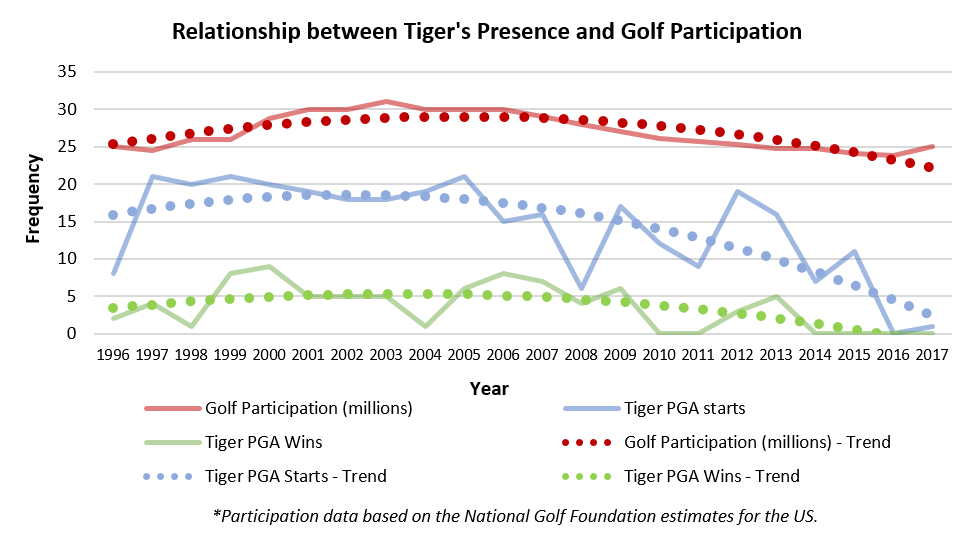The ‘Tiger Effect’
- November 9, 2018
- Business Planning, Insight, Private Clubs, SI Insights

The ‘Tiger Effect’ and How to Leverage the Influence of Tiger Woods on Millennial Golf Interest
On the eve of this year’s Masters Tournament CBS sportscaster Jim Nantz said, "This might be the most anticipated Masters any of us has seen in our lifetime.” And for good reason: the hype surrounding the return of modern golf’s greatest icon to battle it out against a plethora of ‘new age’ stars. Ironically, many of these rising stars say they found their passion and motivation for the game as a direct result of idolizing Tiger’s dominance in the late 1990’s and early 2000’s.
Fast forward to the 2018 Tour Championship, which concluded in storybook fashion with Tiger claiming his 80th career victory and his first in over five years. NBC announced the PGA Tour's season finale drew a 5.21 overnight rating, the highest of any non-major championship this year. That number is also up a whopping 206 percent over last year's event, all the while competing for ratings against NFL Sunday.
Tiger’s impact on the growth of the game has been well documented over the years. Tour earnings increased at 10x the rate of inflation when comparing 1985 to 2010. No one has ever moved the needle in his or her sport more than Tiger Woods. His presence in only a handful of events this year has brought measurable spikes in TV Ratings and tournament attendance. More importantly, for club managers, another byproduct of the ‘Tiger Effect’ is an increase in golf participation levels (defined by the NGF as people age 6+ who played golf on a golf course).
Let’s examine the trend in US golf participation since Tiger burst onto the scene in 1996 with his first victory and began capturing the attention of the golfing world. Since that time, there seems to be an unavoidable lagging correlation between Tiger’s ‘presence’ (number of starts and number of wins) and the golf participation trend. As an example, the two-year time period between 1999 and 2000: it is widely regarded as the height of Tiger’s dominance and included 17 wins and 4 major championships. The lagging effect on golf participation was an increase from 26 million to 31 million golfers in the US over the next three years. Jump ahead to 2008, when Tiger’s first major injury-riddled season limited him to 6 starts and golf participation began a declining trend that was then amplified with the economic downturn and Tiger’s hiatus for ‘off-the-course’ indiscretions. As the economy has recovered in recent years, we find ourselves returning to the level of participation in the mid-90s, the pre-Tiger era.
What that may infer is the jump from 25 million to 30 million has a lot to do with the ‘Tiger Effect’. While we likely won’t experience the same participation rise as we experienced at the height of his dominance, past history suggests that the more we see the red shirt on Sunday afternoons, the more latent golfers will flock to the links. According to the NGF, non-golfers interested in playing golf was 12.8 million in 2017, up from 11.9 million in 2016 and double what it was five years ago. The estimated number who say they are at least ‘somewhat interested’ in taking up golf was 40.6 million, and well over a third of that number (15.2 million) were Millennials (18- to 34-year-olds), which made up the largest single age group of non-golfers who expressed interest in playing golf.
As a Millennial, I can vouch for the declining interest I witnessed in my peer group post-2008. Ten years have passed, and as Tiger tapped in for victory to win the 2018 Tour Championship, my social media feed was flooded with excitement from friends and colleagues who have been on hiatus from the game but are still fans and players at heart. I can’t help but believe that Tiger’s return to the top of golf will provide a ‘kick’ that many latent Millennials need to get the golfing itch back, and with it the decision to become club members again.
To all club managers out there watching your membership continue to increase in age while the club struggles to attract new Millennial members to join, I urge you to promote aggressively this winter and take advantage of the current momentum and excitement among the Millennial audience. It may just be the best opportunity in a decade to attract an audience that is crucial to regenerating the membership pipeline at your Club.
Tactics to consider:
- Organize a ‘golf pool’ for each major championship in 2019 and extend the invitation via social media channels. Encourage members to invite their friends to participate and to visit the Club on the ‘Major Sunday’ for a viewing party social event.
- Consider adding team events/competitions for younger members, specifically in the spring. Again, scheduling these events surrounding major championships can spike interest in latent Millennials who become most engaged during these weekends.
- Be sure the pro shop has Nike/Tiger apparel in the pro shop or club-branded ‘red shirts’ of its own. Perhaps consider a discount sale on all ‘Tiger’ related merchandise in advance of the Masters Tournament next spring.
- Golf simulators resonate strongly with the Millennial audience, reminding them of their days playing the iconic ‘Tiger Woods EA Sports’ video game as a child. If your club has simulators available for use in the winter, allow guests of members to pay-for-use and accumulate credits towards their entrance fee if they decide to join in the Spring.
This article was authored by Ben Hopkinson, GGA Senior Associate and research-and-insights specialist.




